Maintaining proper tire inflation is relatively simple and essential to the overall tire performance of your vehicle. A properly inflated tire will provide longer life, quicker steering response, better fuel efficiency and a smoother ride than an improperly inflated tire. Both underinflation and overinflation can cause headaches like premature treadwear and possible tire failure. The best way to ensure you're getting the most out of your tires is to check your tire pressure on a monthly basis.
Knowing how to use a tire pressure gauge is very simple. Here’s how to check tire pressure and refill your tires.
Items You Need When Checking Tire Pressure
Tire pressure gauge
Air compressor
Pen and paper
Your tire pressure gauge can be digital or standard. Auto parts stores typically carry both. Many auto parts stores sell portable air compressors that run from your car battery or 12v power port. Alternatively, you can use the air compressor found at most gas stations. They usually cost $0.50 or $1.00 to use.
Vehicle manufacturers specify PSI – literally “pounds per square inch” of pressure – assuming tires are cold. Tires are considered cold when the vehicle has been parked for three hours or more, or if the vehicle has been driven less than a mile (1.6 km) at moderate speed. PSI is the unit your pressure gauge uses to provide readings.
Look on the driver’s side door jamb or your owner’s manual to find the recommended cold tire PSI for your front and rear tires. If you cannot find it, you should consult your vehicle dealer, manufacturer, or a qualified tire professional.
If your front and rear tires require different pressure levels, write down the correct PSI for each to avoid getting confused as you move around your vehicle checking tire pressure.
Remove the valve cap from one of your tires. Then place the pressure gauge on the valve stem and press down hard enough so the hiss sound disappears and your gauge provides a reading. With a standard gauge, the air pressure will push a small bar out from the bottom of the gauge. Measurement units are etched into the bar. A digital gauge will show you the reading on a screen.
Write down the reading and repeat this process for all four tires.
Use an air compressor to refill any tires with low pressure. Many air compressors are different, so read directions carefully to be sure you’re using it correctly.
If you’re using the air compressor at a gas station, be sure to park so that the hose will reach all four tires. Insert change into the machine until you hear the motor running. Fill each tire by placing the end of the hose over the valve stem and pressing on the lever.
Using a gas station air compressor means your tires might be “hot.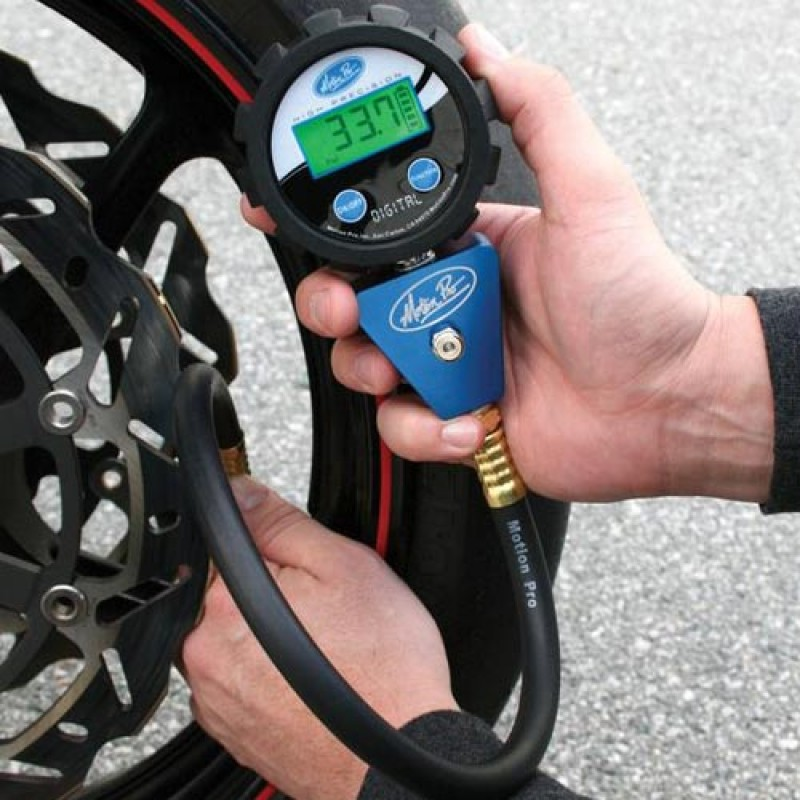 ” If it is necessary to adjust inflation pressure when tires are “hot”, set their pressure to 4 psi (14 kPa) above the recommended cold inflation pressure. Recheck the inflation pressure when the tires are cold.
” If it is necessary to adjust inflation pressure when tires are “hot”, set their pressure to 4 psi (14 kPa) above the recommended cold inflation pressure. Recheck the inflation pressure when the tires are cold.
After filling your tires, use the gauge to check pressure again. At this point, it’s ok if you overfilled the tires because you can always let some air back out. Never drive on overinflated tires. Overinflation can result in decreased traction, premature wear, and decreased impact absorption.
Make the above procedure a monthly ritual. Regularly checking your tire pressure is the best way to ensure your tires never dip far below the optimal PSI.
Accuracy matters and you should keep that in mind when choosing a gauge. For just a few dollars, you can find a quality, accurate tire pressure gauge that gives accurate readings. If you’re not sure which one to purchase, ask a professional technician which he or she prefers.
A digital tire pressure gauge will provide accurate readings, but don’t forget that it operates on a battery. If you think having to replace the battery will prevent you from using it, it’s best to go with a standard gauge.
It’s best to use your personal tire gauge versus those available attached to air hoses at service stations. Of all the pressure gauges out there, they’re the most likely to be weathered, and possibly inaccurate.
There’s never a good time for a flat. That’s why Bridgestone DriveGuard tires are masterfully engineered to keep you moving for up to 50 miles at speeds up to 50 MPH without disruption.
There’s never a good time for a flat. That’s why Bridgestone DriveGuard tires are masterfully engineered to keep you moving for up to 50 miles at speeds up to 50 MPH without disruption.
See Details Find Your Fit
We all know that routine maintenance is important for everything from our computers to our cars.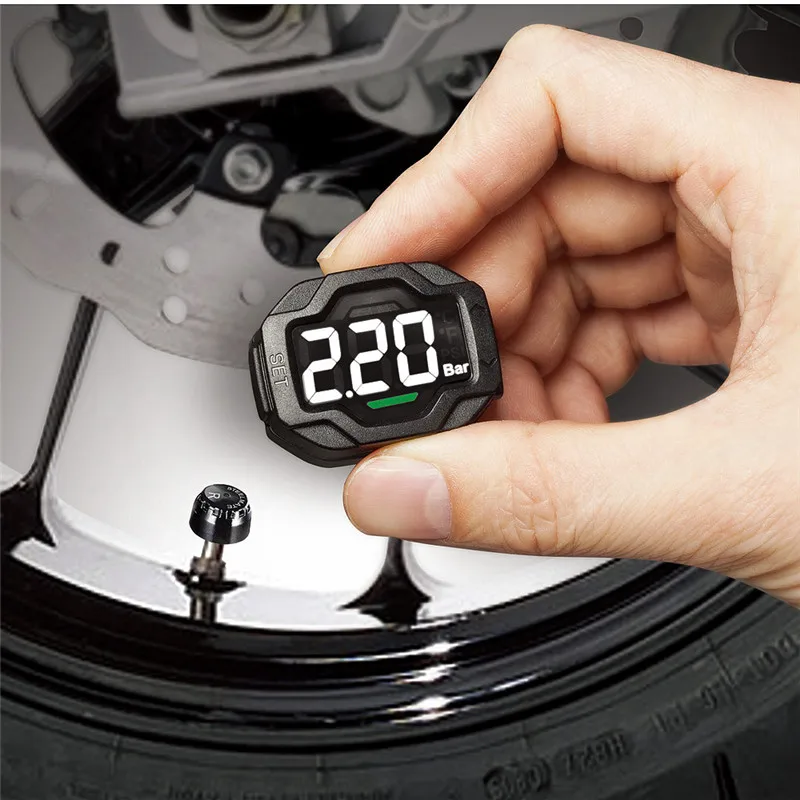 But sometimes, we fall short. One of the most neglected routine car maintenance tasks is to check tire pressures and inflate them as necessary. That’s why newer cars have tire pressure warning lights, or tire pressure monitoring systems (TPMS), that let you know when you have under- or over-inflated tires (when any tire is 25% underinflated).
But sometimes, we fall short. One of the most neglected routine car maintenance tasks is to check tire pressures and inflate them as necessary. That’s why newer cars have tire pressure warning lights, or tire pressure monitoring systems (TPMS), that let you know when you have under- or over-inflated tires (when any tire is 25% underinflated).
Older vehicles don’t have this useful warning light. So, don’t wait for a rupture to check or change a tire. Use this guide to learn how to check the pressure (PSI) of your vehicle tires and how to inflate them to the proper air level.
Why should you check your tire pressure?The number one reason why you should periodically check your tire pressure is SAFETY, but there are monetary and handling reasons as well:
Proper tire pressure (as recommended by the manufacturer) is needed to drive safely and efficiently. According to a 2009 report by the National Highway Traffic Safety Administration:
According to a 2009 report by the National Highway Traffic Safety Administration:
“…about 28% of light vehicles on our Nation’s roadways run with at least one underinflated tire. Only a few psi difference from vehicle manufacturer’s recommended tire inflation pressure can affect a vehicle’s handling and stopping distance. Poor tire maintenance can increase incidences of blowouts and tread separations. Similarly, underinflation negatively affects fuel economy.”
When your tires are underinflated, the tires get fatter, increasing their surface area. This causes high heat generation and extra resistance that could result in higher fuel costs, blown out tires, tire wear, and loss of control.
If you feel like you’re spending too much at the gas pump, it might be your tires. According to the US Department of Energy:
“You can improve your gas mileage by 0.6% on average—up to 3% in some cases—by keeping your tires inflated to the proper pressure.
Under-inflated tires can lower gas mileage by about 0.2% for every 1 psi drop in the average pressure of all tires.”
In addition to safety and fiscal concerns, keeping your tires properly inflated will also reduce your impact on the environment. When your tires are properly inflated, you’ll pay less for gas, replace your tires less often, and improve your handling and stopping distance. You’ll also feel better knowing that you are emitting less carbon dioxide and other harmful substances into the atmosphere.
What is the right PSI level?PSI stands for pounds per square inch. The recommended PSI for your vehicle’s tires is determined by the vehicle’s manufacturer and the recommended tire size.
One big question that we get is whether you should follow the recommended PSI level on the tire itself or the recommended PSI level printed in your owner’s manual or on the placard inside of door edge, glove box door, or fuel door.
Do NOT use the max PSI that is printed on the tire sidewall. This is not the recommended PSI level. The pressure amount on the tire is normally the maximum allowed pressure. The correct PSI level is almost always less than what you see printed on the side of the tire. Over-inflation can lead to poor handling and comfort, overheating and blow outs. Over 40 PSI is a dangerous level for most vehicles!
Make sure you always use the recommended PSI as provided in your owner’s manual and don’t go any more than 5 PSI over the recommended level. You should make sure, however, that your tires are appropriate for your vehicle. You can do this by checking the car’s owner’s manual or the placard that is on the inside of the driver-side door, glove box, or fuel door.
Most car tire pressure recommendations range from 30-35 PSI.
How often should I check tire pressure?A question in many minds is when is the appropriate time and frequency for checking and inflating vehicle tires.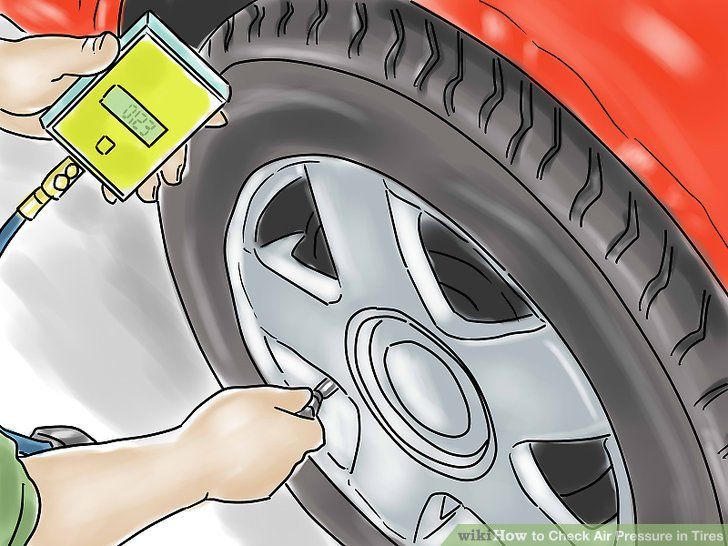
A quick google search will reveal a variety of different opinions and suggestions. Some say that you should check your tire pressure every 2nd visit to the gasoline station, while others say once every 3-6 months is OK.
Most tire and vehicle manufacturers, on the other hand, will say that you should check your tire pressure at least once every month, or every second trip to the gas pump. Your tires will lose around 1 PSI each for every month that goes by.
Unfortunately, not one answer will fit every situation. There are several factors that influence how often you should check your tire pressure, including:
Did you know that for every 10°-drop in temperature, you lose 1 pound of pressure?
If you have a leaky valve or a small puncture, you will lose air pressure much more quickly. This is one more reason why you should frequently check the tire pressure on all of your tires.
Since tire pressure constantly fluctuates, it’s important to check it periodically (at least once a month) and add air as necessary.
How to Check Tire PressureFinding out the tire pressure of your tires is incredibly easy. All you need is a pressure gauge (click here for additional items you should have in your vehicle).
Just make sure that you are checking your tires when they are relatively cold. If you check your tire pressure after a long drive, you will get an inaccurate reading since heat will temporarily increase the tire pressure reading.
Unfortunately, not all pressures gauges are created equal. Some are better than others. We recommend shelling out a couple extra bucks for a digital reader. The pop-up, stick-type versions are notoriously inconsistent and unreliable. A reliable gauge will be well worth the investment. Prices range from about $5 for the stick-type and about $30 for the digital and dial-type pressure gauges.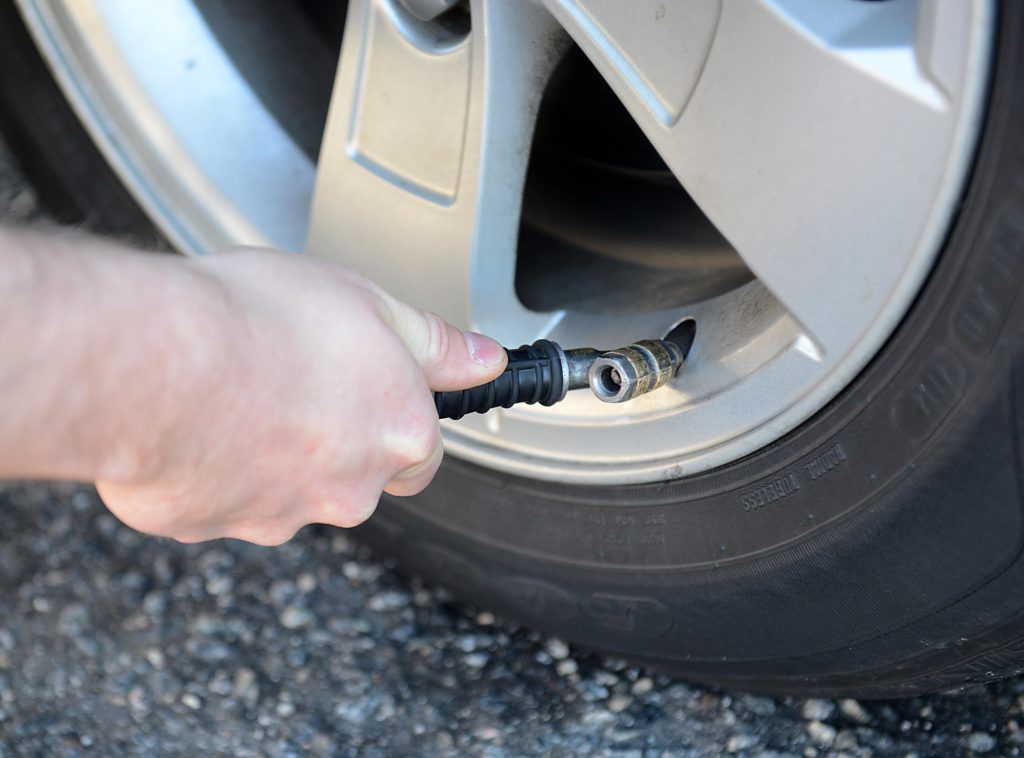
You can also check your tire pressure at most gas stations or auto repair shops. Discount Tire offers free tire pressure checks and inflation.
Here are the steps for checking your tire pressure: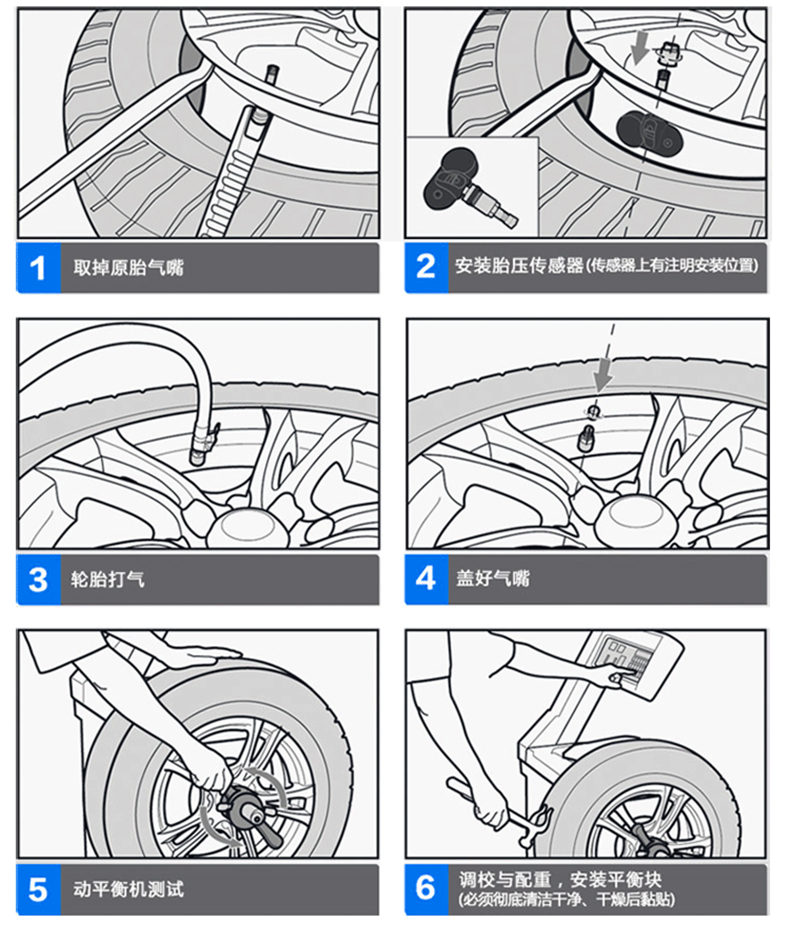 Check the tire pressure again. Release more air if necessary. If you release too much air, you can always add some air back.
Check the tire pressure again. Release more air if necessary. If you release too much air, you can always add some air back.It should only take you a couple minutes to check the air pressure of your vehicle’s tires. As soon as you restore tire pressure to the recommended levels, you’ll start experiencing the safety and savings that come with this regular maintenance task.
Watch this video for more information on how to check your tire pressure:
How to Inflate TiresHere are the steps for adding air to your tires:
 Instead, go to your local gas station that has a coin-operated air pump (ask the attendant if you can’t find it). You can also purchase your own automatic air compressor, but it will cost you around $50-$150.
Instead, go to your local gas station that has a coin-operated air pump (ask the attendant if you can’t find it). You can also purchase your own automatic air compressor, but it will cost you around $50-$150.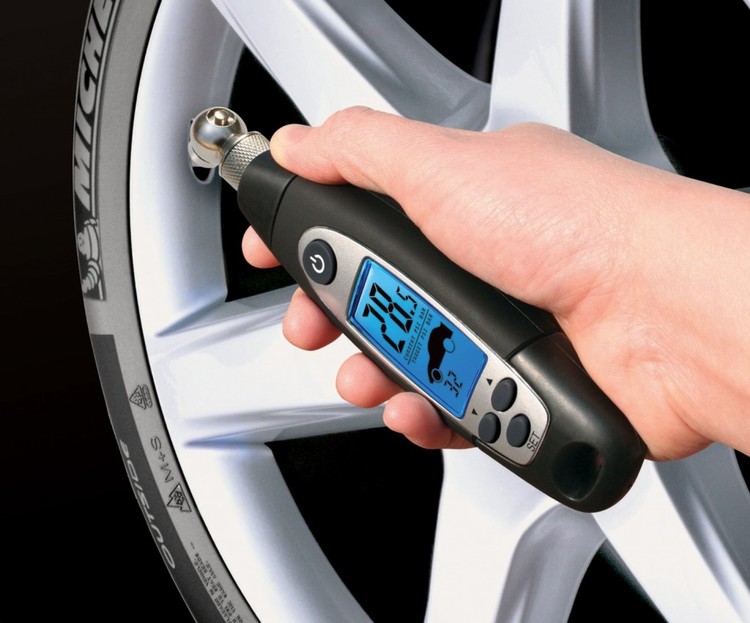 Hold it firmly against the valve as you listen to the air filling the tire.
Hold it firmly against the valve as you listen to the air filling the tire. You’ll want to screw them back on now.
You’ll want to screw them back on now.Remember, just one drop in PSI can lower your gas mileage by about 0.2%. For every 3-4 PSI units that your tire is underinflated, you are burning around 1% more fuel.
If your tires are flat, then you probably have a leak. Add air and see if you can drive around without the pressure dropping. If you hear air escaping the tire while you are filling up, then it’s time to replace the tire.
Tip: Learn how to use the air pump properly first. Some automatic air pumps at gas stations have a handle/switch that you need to depress in order for the air to flow. When you let go of the handle, a tire pressure gauge will pop out showing you the tire pressure. At the same time, air will be slowly released. If your air pump has this kind of handle, then you will want to hold down the handle for most of the time, periodically releasing it to check the pressure reading. Consult your own tire pressure gauge for accuracy.
When should I replace my tires?If you check your tire pressure at least once a month as recommended, you’ll also get a good idea of the general condition of your tires and when you should replace them.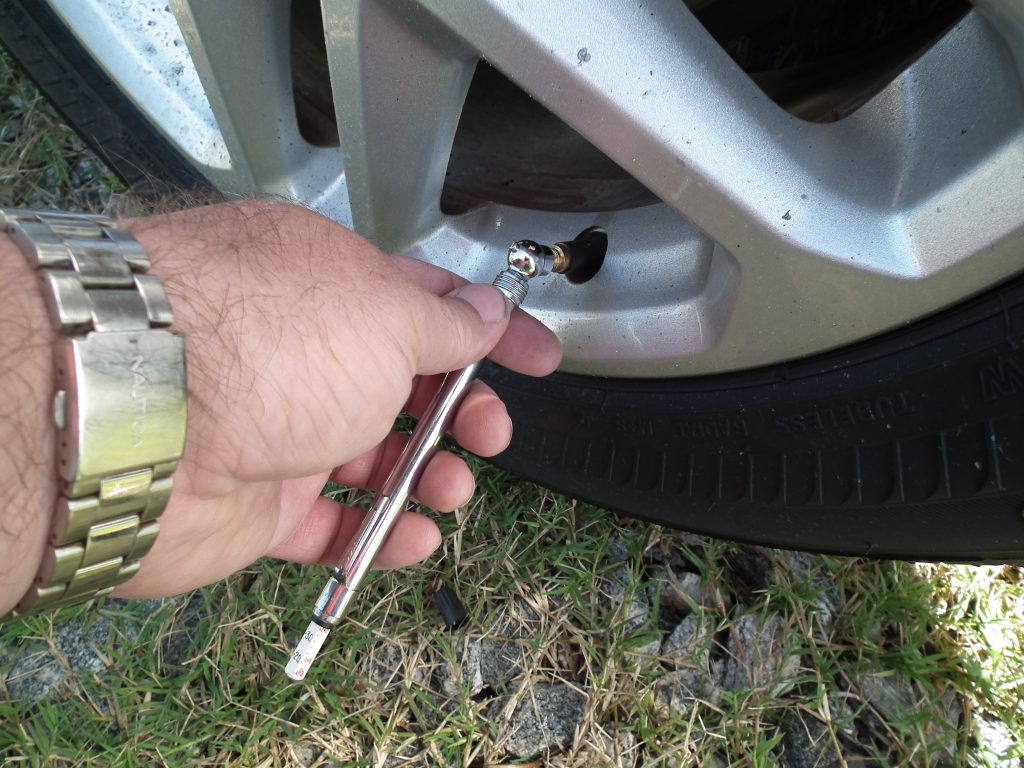
We recommend using the penny test:
Source: bridgestonetire.com
Click here for more car maintenance tips. Click here for car winterization tips.
Auto Simple wants you to find a vehicle you love at a price you can afford. We carry a large selection of hand-picked, Certified Pre-Owned vehicles, all with a 6 month/6,000-mile Powertrain Warranty.
If you have any questions, don’t hesitate to speak with one of our Online Specialists or give us a call:
Chattanooga, TN – (423) 551-3600
Cleveland, TN – (423) 476-4600
Dayton, TN – (423) 775-4600
Dalton, GA – (706) 217-CARS (2277)
Follow us on social media for more useful information on buying, selling, and maintaining vehicles: Facebook, Twitter, Youtube, and Google+.
Thoughtful? However, few motorists can immediately answer this question. In Europe, sampling surveys are regularly carried out to measure the air in tires. The results are almost always disappointing: only every fourth car has a normal pressure. 10% of drivers generally risk their lives, they drive with ultra-low tire pressure. Their tires are lowered by more than 0.6 bar. Keep in mind that car tires lose air every day. And the monthly loss can be several hundredths of an atmosphere. And if you are irresponsible about the air pressure in the tires, then over time the motorist will be among those 10% of people who risk their safety.
Tire pressure affects many vehicle characteristics. In a properly inflated tire, the load is evenly distributed across the contact patch. Normal tire pressure allows you to use the maximum capabilities of the car and prolongs the life of the tire.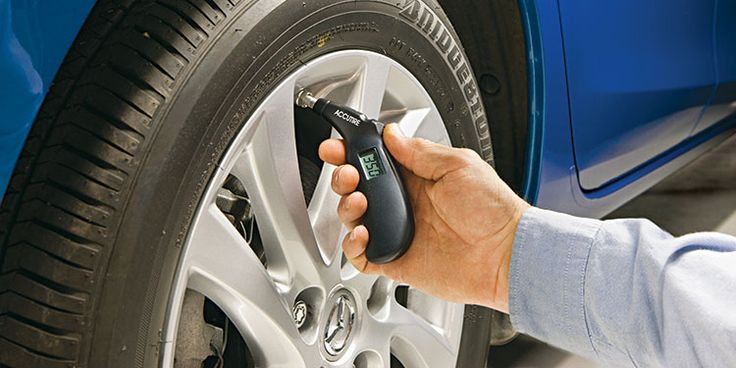 By the way, the air pressure in tires is measured in bars, atmospheres and kgf / cm2. These units are equivalent, i.e. 1 bar \u003d 1 atm. \u003d 1 kgf / cm2.
By the way, the air pressure in tires is measured in bars, atmospheres and kgf / cm2. These units are equivalent, i.e. 1 bar \u003d 1 atm. \u003d 1 kgf / cm2.
Automotive tires are divided into ultra-low (pneumatic), medium, high, adjustable pressure tires and low pressure tires.
What is the recommended tire pressure? This value is prescribed by the vehicle manufacturers and is contained in the operating instructions. The optimal value can be found from the inscriptions on the gas tank cap, driver's door pillar or glove compartment. This sticker contains the load index, recommended cold tire pressure and tire size. In addition, manufacturers can specify a tire interchangeability list for a given vehicle.
Normal tire pressure is the manufacturer's recommended value. Driving on a properly inflated tire becomes safer and more economical due to reduced fuel consumption. In addition, the service life of the tire is increased. Deviation from the norm of air pressure in the rubber leads to uneven wear of the tread. For example, a lack of 0.2 bar in tires reduces tire life by 15%. A tire with a pressure of 0.6 bar below normal wears out almost twice as fast. Air pumping, which is less common, also causes premature tire wear.
Deviation from the norm of air pressure in the rubber leads to uneven wear of the tread. For example, a lack of 0.2 bar in tires reduces tire life by 15%. A tire with a pressure of 0.6 bar below normal wears out almost twice as fast. Air pumping, which is less common, also causes premature tire wear.
Due to too low pressure, the grip of the tire with the road worsens, the braking distance increases, the car becomes less obedient. An under-inflated tire can even burst. Higher than normal pressure reduces the contact area with the road, so the central part of the tread will suffer from too high a load.
Incorrect tire pressure must be adjusted in a timely manner. Otherwise, it may cause an accident. Now, fewer and fewer motorists manually inflate tires with a pump, preferring to turn to specialists. In addition, it is becoming more and more popular to inflate tires with nitrogen.
How can you check tire pressure? Most drivers use common folk methods: eyeballing or kicking tires. But, you see, the eyes and legs are not a pressure gauge, not a special device for measuring tire pressure. Therefore, it is hardly possible to determine by eye the difference between 1.5 atm. and 2.
But, you see, the eyes and legs are not a pressure gauge, not a special device for measuring tire pressure. Therefore, it is hardly possible to determine by eye the difference between 1.5 atm. and 2.
Tire pressure should be checked at least once every 30 days. Before checking tire pressure, make sure the tire is cold. While driving, the pressure can rise up to 20%. Therefore, it should be measured no earlier than 2 hours after the trip. By the way, modern cars are equipped with a tire pressure monitoring system. Therefore, information about deviations from the norm is promptly displayed on the dashboard in the car.
Sometimes changing the tire pressure relative to the norm can help the motorist in difficult road conditions. Very often, manufacturers indicate tire pressures for normal and full vehicle loads. But sometimes there is only one meaning. In this case, when fully loaded, you need to change the tire pressure, increase it by approximately 0.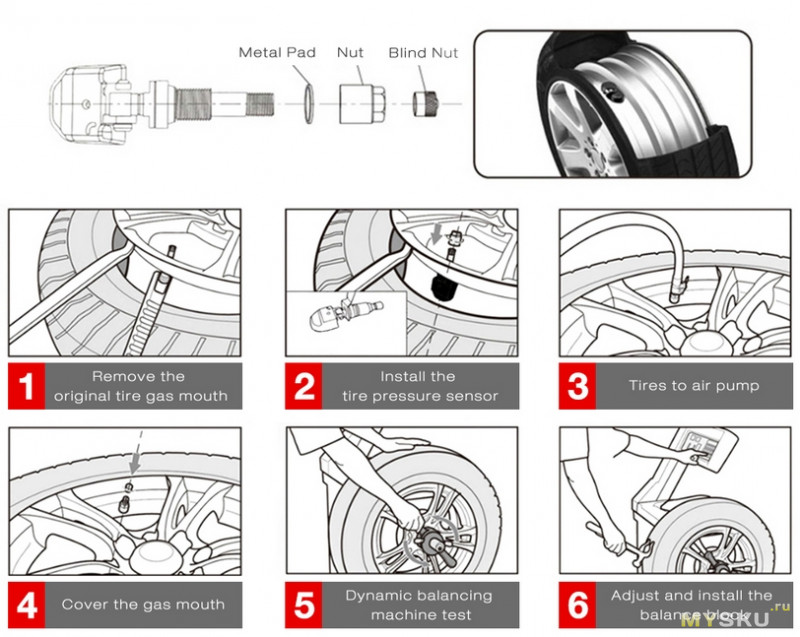 3-0.5 atm. The same change in pressure should be in the tires before a long trip.
3-0.5 atm. The same change in pressure should be in the tires before a long trip.
If you plan to travel off-road, then the tires can be slightly lowered. This change in pressure will improve flotation through mud or clay. When driving on rocky roads, increasing tire pressure will help protect the sidewalls from damage. But, most importantly, after overcoming a difficult road, do not forget to bring the pressure back to normal.
When a different tire size is fitted to the vehicle, the tire pressure must match the full load value. If new tires have a lower load-carrying capacity than standard tires, the pressure should be increased by 0.1 atm. per unit load. For tires with an Extra Load and Reinforsed index, the pressure should be 0.4 atm higher than the maximum.
In winter, tire pressure should be closely monitored. Ambient temperature has a noticeable effect on pressure. The colder it is outside, the less pressure in car tires.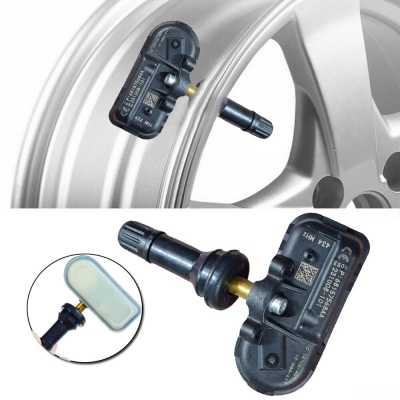 Therefore, in winter, the tire pressure must be increased by 0.2 bar.
Therefore, in winter, the tire pressure must be increased by 0.2 bar.
A cold snap of 10°C can change the pressure in a winter tire by 0.1 bar. In winter, the air in the tires should be checked once every two weeks, and with sudden changes in air temperature.
Not so long ago, scientists from different countries conducted an experiment, during which it was revealed that only a small part of vehicle owners check the amount of atmosphere in the chambers before going on a trip. Meanwhile, it is insufficient or excessive pressure that often causes increased fuel consumption, uncomfortable driving, or leads to an accident.
The TPMS system comes to the rescue, designed to control the amount of atmosphere in the chambers and signal malfunctions in a timely manner. When the tires are properly inflated, the special warning sensor does not light up. However, in some situations, the light comes on. A constantly burning signal will begin to annoy even the calmest driver, especially if the amount of atmosphere in the chambers is ideal. A few simple manipulations will help fix the sensor error, and a couple of tips will tell you how to properly configure the TPMS system.
A constantly burning signal will begin to annoy even the calmest driver, especially if the amount of atmosphere in the chambers is ideal. A few simple manipulations will help fix the sensor error, and a couple of tips will tell you how to properly configure the TPMS system.
The TPMS sensitively monitors the amount of atmosphere in each chamber. However, to avoid possible troubles, it is important to know that the indicators are working properly. No, for this you do not have to constantly run around the car with a variety of measuring instruments. You just need to regularly adjust the device.
It is important to remember that for each particular car model, the sensor manufacturer has set its own values for a particular season. It is these characteristics that must be given to the TPMS system.
Manipulations are quite simple and do not require special experience. It all depends on which variety is used:
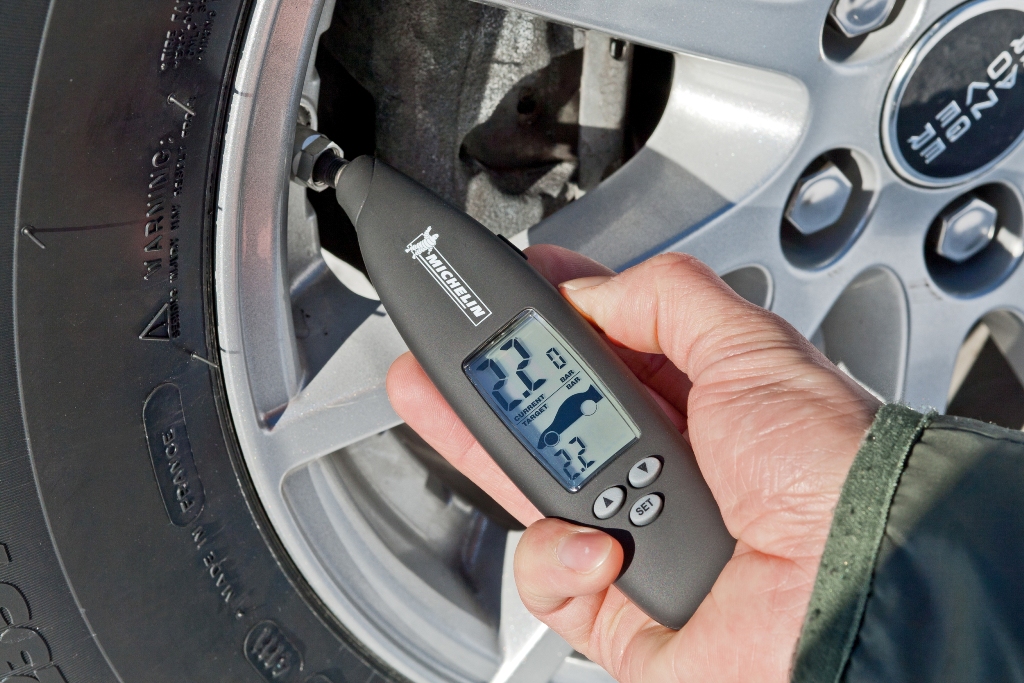 Convenient and easy to use. The device simply needs to be installed in place of the nipple tip. No further action is required.
Convenient and easy to use. The device simply needs to be installed in place of the nipple tip. No further action is required.  If readings are taken from the included display, no additional device settings are required.
If readings are taken from the included display, no additional device settings are required. To prevent the light from flashing again for no reason, it is important to set up the device every time you make a change. For example, if the old wheels were replaced with a new set, balancing was done and so on.
The TPMS is easy to use. The main thing is to carefully study the attached instructions and make sure that the number of atmospheres in the chambers matches those recommended by the manufacturer.
@Firedis.com
External and mechanical models are disabled by removing the sensors, because without removing them, the system will not turn off. There are several ways to make TPMS useless:

The following manipulations can also help to eliminate the error in the system:
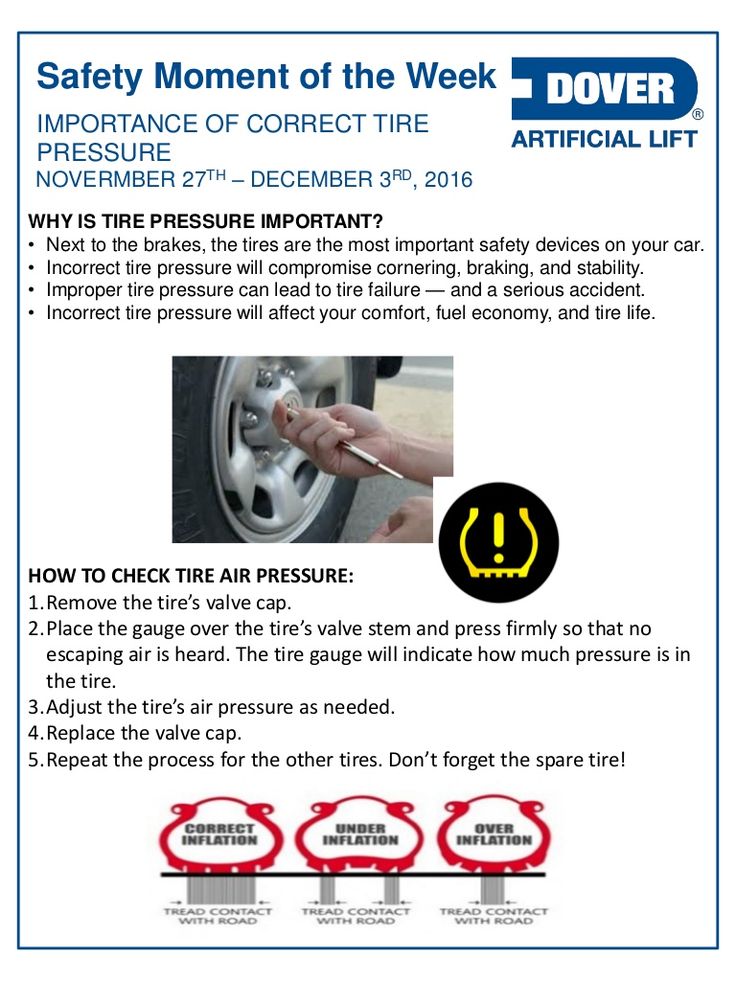 2 bar to it. If the signal continues to burn, you should completely lower the wheels. Then you need to re-inflate the tires, drive 5 km at a speed not exceeding 30 km / h. So the sensor data is completely reset, and the system will stop giving an error.
2 bar to it. If the signal continues to burn, you should completely lower the wheels. Then you need to re-inflate the tires, drive 5 km at a speed not exceeding 30 km / h. So the sensor data is completely reset, and the system will stop giving an error. TPMS is definitely useful and easy to use. But even modern devices have some drawbacks that may force the driver to dismantle the product.
So, tire pressure monitoring has the following disadvantages:
 The reason lies in the fact that the angular speeds of the inner and outer wheels in this situation will be different.
The reason lies in the fact that the angular speeds of the inner and outer wheels in this situation will be different. @Creta-fan.ru
Sometimes the above methods of turning off the sensors are not able to solve the problem. In this case, the first step is to check the health of the indicators. To do this, it is better to contact a specialized workshop or an authorized dealer. The most common reason for indicators not working correctly is damage to the device.
Thus, instruments can be damaged:
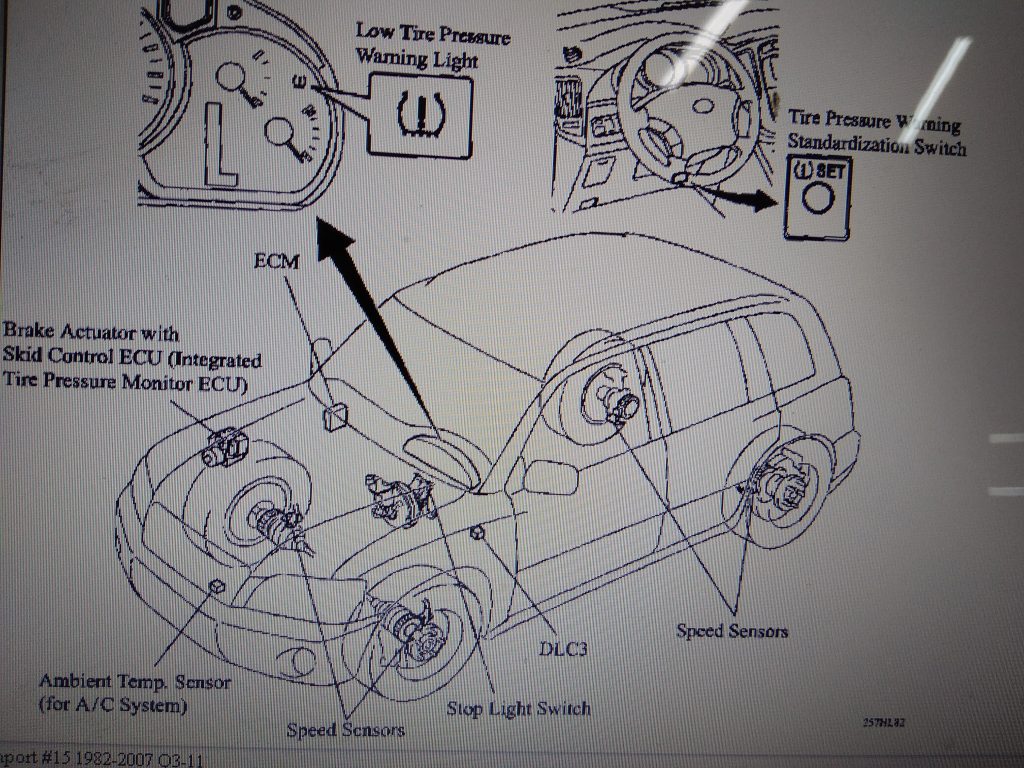
In some cases, the sensors may turn on by themselves, indicating a serious problem. Provoke incorrect operation can:
In the latter case, the ABS indicator will also come on. This suggests that the car needs to be diagnosed in a specialized center where employees will find and fix the problem.
The permanently lit TPMS indicator is an annoying factor for any car enthusiast. Even if everything is fine with the wheels, a faulty indicator deprives the vehicle owner of control over the true amount of atmospheres in the chambers. After all, if the light is on all the time, the motorist will not receive an alert when the camera is really faulty. And this factor already directly affects not only the comfort, but also the safety of the driver and passengers.